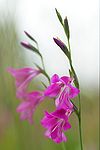Burn (habitat)
As Brenne one is gritty micro habitat called, has the characteristics of very dry and warm conditions, though it naturally occurs in a riparian forest is created. The sun-exposed location in connection with water-permeable soils (washings and sandbanks of near-natural rivers and streams) of a Brenne creates particularly warm microclimates. In Austria this type of habitat is known as hot land .
description
Burns are usually found in the area of influence or in the immediate vicinity of a larger river. Debris that was brought in by the river causes the formation of grasslands and dry grasslands . Any rainwater that arises is quickly drained into the soil, which is covered by a thin layer of humus . This humus layer is not able to store large amounts of water. Such habitats are known for their abundance of orchids, especially when the rock material is calcareous.
We often find burning on the central Danube , the Isar and the Lech . There they are mostly enclosed by alluvial forest or pine heather areas. These shield the burn from wind and drafts, which results in significantly higher temperatures than in the surrounding area. In midsummer, temperature maxima of up to 50 ° C are reached.
Due to the former river profile, troughs, depressions and gullies were mostly able to develop. Certain microclimates prevail in them, which are already damp and can create conditions that are actually untypical for this habitat. Humidity and loess or humus blown in by the wind thus also offer botanical border crossers settlement space.
Habitat Brenne
The conditions of the Brenners offer especially specialized animal and plant species a retreat. Particularly warmth-loving plants, which are highly endangered, settle there, including numerous orchids such as mosquito-handelwort , fire orchid , helmet orchid , bug orchid and all kinds of Central European ragwurzen . Plants from the Alpine region used the rivers as floral bridges and have gained a foothold on the brandy, such as the stemless gentian or the spring gentian .
Many reptiles offer the heat-favored burning an ideal habitat; species such as the sand lizard or the smooth snake can be found on them .
See also
- Lechaue west of Todtenweis , a nature reserve with larger burns

